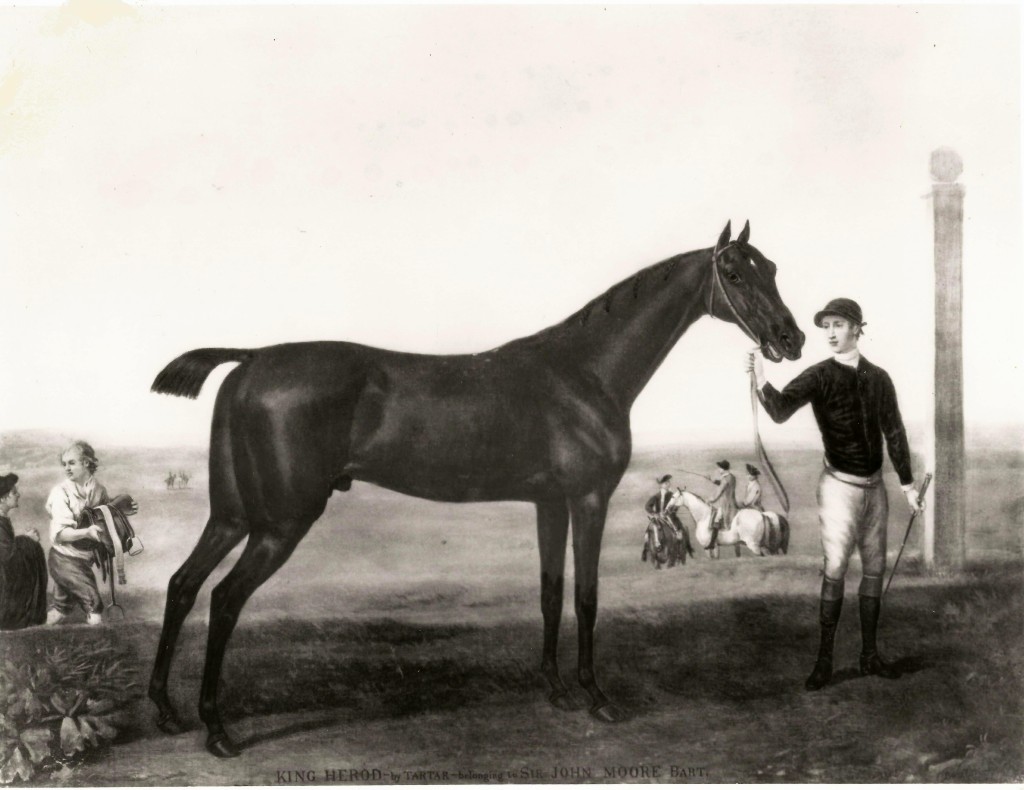HEROD on the Racecourse & at Stud
Although their paths never crossed on the racecourse, Herod and Eclipse were rivals at stud for a decade. Herod was Champion Sire eight consecutive years 1777-1784, whilst Eclipse, although never Champion Sire, was a runner-up in the 11 years 1778-1788.
One dominant reason for Herod’s overwhelming success at stud was the reluctance of the aristocracy to do business with the self styled, Count Dennis O’ Kelly.
O’Kelly left Ireland, coming to London in 1745, to improve his frugal living. He started as a sedan chairman then, became a billiards marker, until eventually forming a friendship with Charlotte Hayes, a woman with a notorious reputation. Both were released from Fleet Prison in 1760, on the death of George II, and from then on they worked their way through society, she, with her feminine ways and he, as a sharp practising gambler. At Epsom, in May, 1769, from winning his historic bet of, “Eclipse first, the rest nowhere,” Dennis O’Kelly went on to buy Eclipse outright, and despite Eclipse’s dominance on the racecourse – unbeaten in 18 starts – when sent to stud, many of the aristocracy shunned the uncouth O’Kelly and sent their best mares to Herod.
But now it’s time to hear about the life of Herod (b.c. 1758) – Champion racehorse and Champion sire.
“KING HEROD was a remarkable fine horse, with uncommon power, and allowed to be one of the best bred horses this kingdom ever produced, and as a stallion inferior to none, being sire of a larger number of racers, stallions and broodmares than any other horse either before or since his time.”
So reads a contemporary description in William Pick’s Racing Calendar.
First entered in the General Stud-Book as King Herod, he was later more commonly called Herod.
A bay colt by Tartar (a great-grandson of the Byerley Turk) out of Cypron by Blaze, Herod was bred by William, Duke of Cumberland (the breeder of Eclipse), at his stud in Windsor Forest.
Over his first two seasons as a five and six year-old, Herod was unbeaten in four starts. The last of these for 500 guineas, against Antinous (rec’d 3lbs), over the Beacon Course, at Newmarket, provoked the beaten connections to call for a return Match at double the stake and with a pull of 9lb. The Match caused a great deal of interest and was run the following spring, with Antinous once again starting favourite. But the difference in weight appeared to make no difference to Herod who again won easily. However, later that year, Herod’s first defeat came when conceding a stone to Ascham, over the Beacon Course, for 1,000 guineas.
After the death of the Duke in 1765, Herod was purchased by Sir John Moore. The colt was beaten a further twice the following year: first by Turf (rec’d 6lb), for 1,000 guineas over the Beacon Course in April, and then by Bay Malton in York’s Great Subscription Purse. During the latter race, Herod sustained a burst blood vessel in his head, and for a time was dangerously ill. He did not race again that year.
At nine, he finished second to Bay Malton over the Beacon Course, but ahead of both Ascham and Turf. The following May, Herod ran his last race, a Match over the same course, for 1,000 guineas, against Ascham (gave 7lbs), which he won in fine style.
Herod was the Champion Sire for eight consecutive years from 1777 to 1784. His best progeny were Highflyer (b.c. 1774), the 13 times Champion Sire; Woodpecker (ch.c. 1773), a winner of 15 races and runner-up Champion Sire four consecutive years, and Florizel (b.c. 1768), the sire of four Classic winners, including the first Derby winner Diomed (ch.c. 1777). Herod also sired the dams of ten individual Classic winners.
It was said that breeders of the day singled out Herod for his toughness and courage in running, despite a tendency to break blood vessels. They also discovered that, when his offspring were put to those of Eclipse, they produced winners – Classic winners.
Herod stood at Netherhall, Bury St Edmunds, Suffolk. The sire of 13 crops, he got the winners of 1,042 races, valued at £201,502 (the equivalent of more than £13 million today). He died on 12 May, 1780, aged 22 years.
